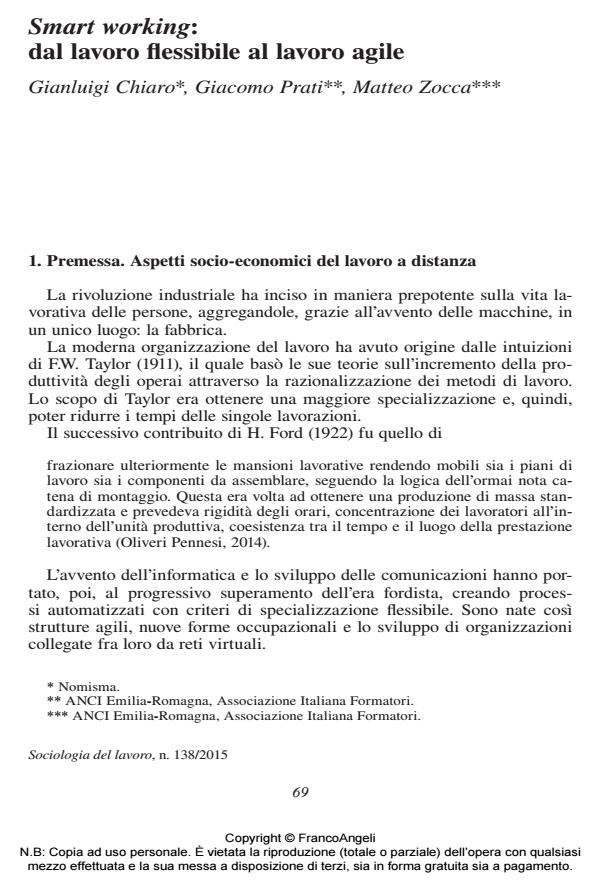Smart working: dal lavoro flessibile al lavoro agile
Titolo Rivista SOCIOLOGIA DEL LAVORO
Autori/Curatori Gianluigi Chiaro, Giacomo Prati, Matteo Zocca
Anno di pubblicazione 2015 Fascicolo 2015/138
Lingua Italiano Numero pagine 19 P. 69-87 Dimensione file 181 KB
DOI 10.3280/SL2015-138005
Il DOI è il codice a barre della proprietà intellettuale: per saperne di più
clicca qui
Qui sotto puoi vedere in anteprima la prima pagina di questo articolo.
Se questo articolo ti interessa, lo puoi acquistare (e scaricare in formato pdf) seguendo le facili indicazioni per acquistare il download credit. Acquista Download Credits per scaricare questo Articolo in formato PDF

FrancoAngeli è membro della Publishers International Linking Association, Inc (PILA)associazione indipendente e non profit per facilitare (attraverso i servizi tecnologici implementati da CrossRef.org) l’accesso degli studiosi ai contenuti digitali nelle pubblicazioni professionali e scientifiche
Il contributo descrive il percorso storico del lavoro a distanza: dal telelavoro allo smart working. L’articolo analizza lo sviluppo del telelavoro negli ultimi anni, in particolare in Italia, proponendo una comparazione con gli altri paesi europei. Si approfondisce il ruolo che le tecnologie hanno avuto nell’espansione di questa pratica e ci si sofferma su limiti e potenzialità della sua naturale evoluzione: il “lavoro agile”. Attraverso la presentazione delle recenti normative emanate dai governi, si ipotizza, infine, che lo smart working sia una concreta possibilità per le organizzazioni di responsabilizzare le proprie risorse umane. Si ritiene che, anche attraverso queste moderne forme di flessibilità, si possano sviluppare la capacità di autonomia dei lavoratori e, allo stesso tempo, si possa prestare maggiore attenzione alle necessità del singolo individuo, sempre più bisognoso di equilibrio tra tempo di lavoro e vita privata.
Parole chiave:Smart working, telelavoro, flessibilità, lavoro agile, tecnologie, lavoro a distanza
- Coworking (ISBN:978-88-5518-391-8)
- HR Analytics and Digital HR Practices Lucio Todisco, Gianluigi Mangia, Paolo Canonico, Andrea Tomo, pp.51 (ISBN:978-981-16-7098-5)
- Need for space. How artists rely on space to face precarious work conditions Damiano Razzoli, Stefano Rodighiero, Lorenzo Mizzau, Fabrizio Montanari, in SOCIOLOGIA DEL LAVORO 157/2020 pp.164
DOI: 10.3280/SL2020-157009 - ‘Another work routine is possible’: everyday experiences of (unexpected) remote work in Italy Alessandro Gandini, Emma Garavaglia, in Culture and Organization /2023 pp.397
DOI: 10.1080/14759551.2023.2201003 - Exploring Digital Resilience Sabrina Bonomi, Daria Sarti, Teresina Torre, pp.261 (ISBN:978-3-031-10901-0)
- Isolamento professionale e inclusione nell'esperienza del lavoro da remoto durante la pandemia in Italia Micol Bronzini, Enrico Cori, Daria Sarti, Teresina Torre, in PRISMA Economia - Società - Lavoro 1/2023 pp.68
DOI: 10.3280/PRI2022-001005 - Working in Digital and Smart Organizations Teresina Torre, Daria Sarti, pp.249 (ISBN:978-3-319-77328-5)
- Organizing in a Digitized World Enrico Cori, Daria Sarti, Teresina Torre, pp.41 (ISBN:978-3-030-86857-4)
Gianluigi Chiaro, Giacomo Prati, Matteo Zocca, Smart working: dal lavoro flessibile al lavoro agile in "SOCIOLOGIA DEL LAVORO " 138/2015, pp 69-87, DOI: 10.3280/SL2015-138005